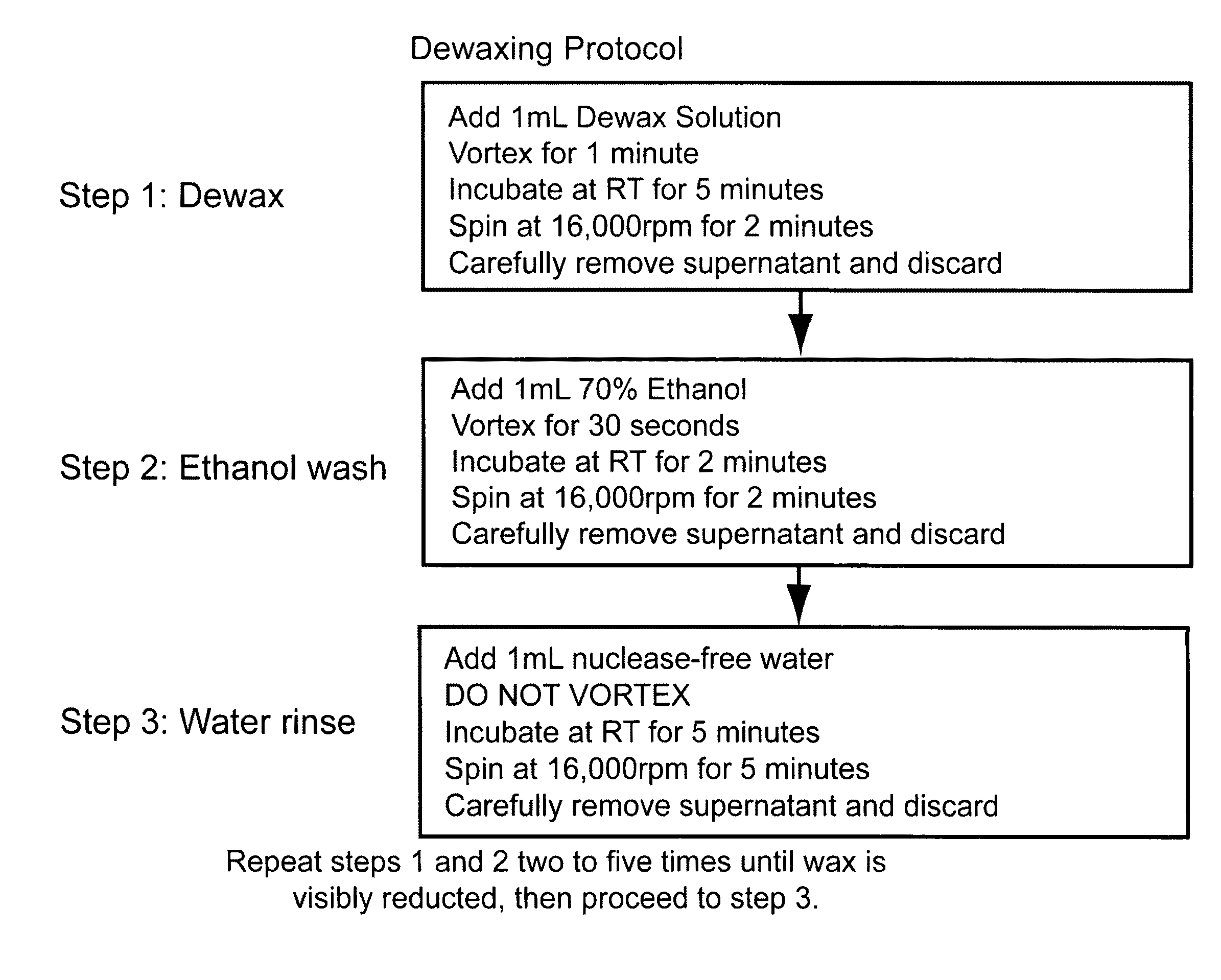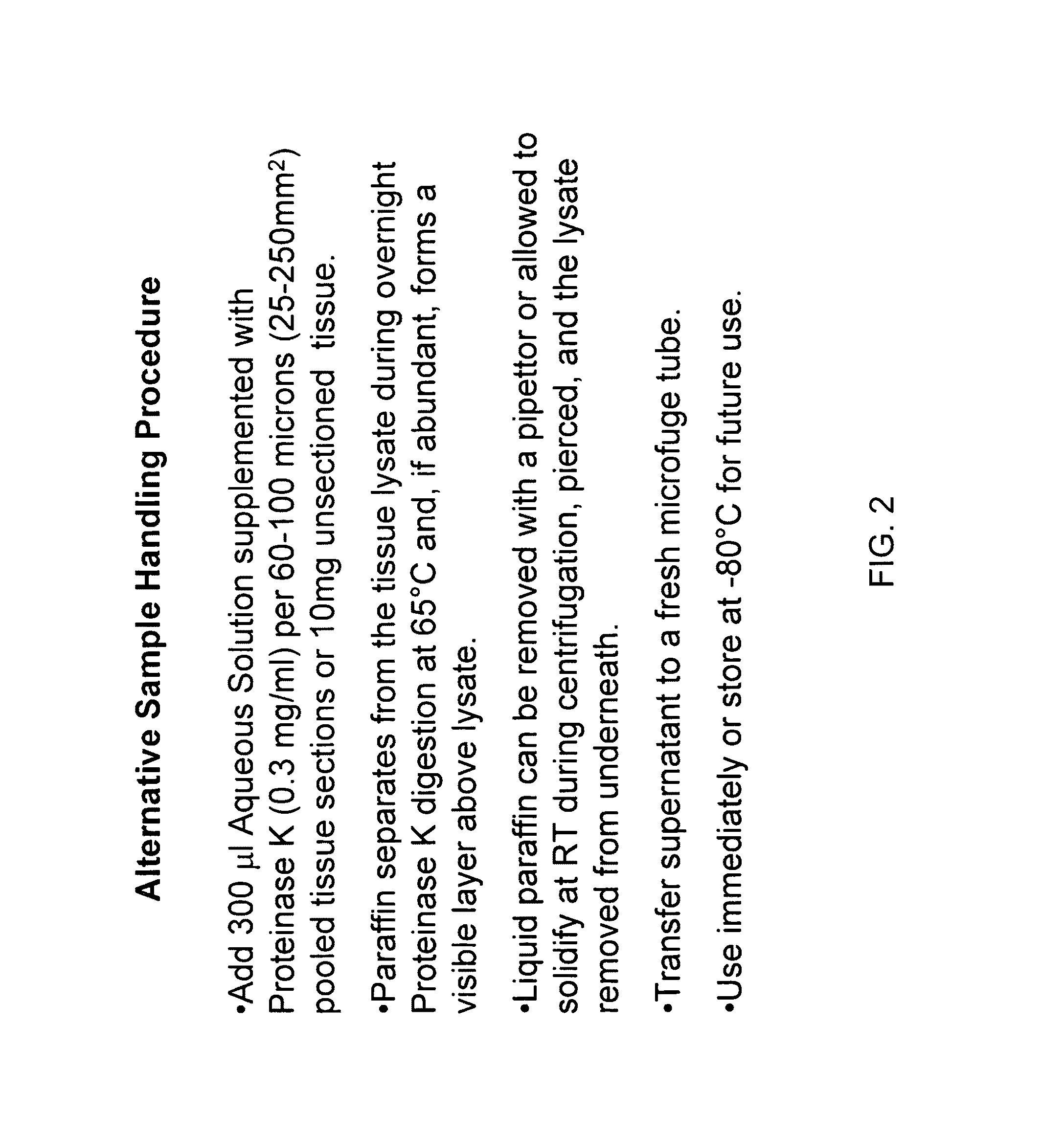Nucleic acid quantitation from tissue slides
a tissue slide and nucleic acid technology, applied in the field of nucleic acid extraction and quantitation from cells and tissues, can solve the problems of time-consuming, laborious, cumbersome, etc., and achieve the effects of improving the estimation of mrna copy counts, increasing sample analysis accuracy and sensitivity, and increasing the sensitivity to target fragmentation
- Summary
- Abstract
- Description
- Claims
- Application Information
AI Technical Summary
Benefits of technology
Problems solved by technology
Method used
Image
Examples
example 1
Comparison of Post-Homogenization Separation to Pre-Homogenization Extraction of FFPE Tissue Slide Hydrophobic Components
[0134]To demonstrate equivalence and improvements of post-homogenization separation over pre-homogenization organic extraction, FFPE sample mRNAs were compared using the branched DNA technology with and without pre-solubilization dewaxing. Samples from >10 yr-old matched human lung normal and tumor FFPE samples were pooled as three 10 micron sections. For one pair of samples (“0”), homogenates were prepared with wax separation after solubilization. For a second pair of samples (“1”), homogenates were prepared with 1× dewaxing organic extraction step before solubilization. For a third pair of samples (“2”), homogenates were prepared with 2× dewaxing organic extraction cycles. Extracts were tested using ribosomal protein S3 (RPS3, NM—001005 housekeeper or Reference control RNA) and Lactate dehydrogenase A (LDHA, NM—005566; 2-3× induction in tumor samples) as describ...
example 2
Equivalent Spike Recovery from FFPE Samples
[0136]An additional experiment was performed demonstrating that the recovery of RNA from FFPE sections is equivalent for post-solubilization separation and pre-solubilization extraction. Methods were as described above for the Lactate dehydrogenase A (LDHA, NM—005566) and ribosomal protein S3 (RPS3, NM—001005), except a known amount of in vitro transcribed (IVT) RNA from the bacterial gene dihydrodipicolinate reductase (dapB, L38424 not expressed in the human lung tissue) was added to a solublized FFPE sample. The data show yields were comparable between the 2× dewax extraction technique and physical wax separation technique. Using either procedure, the capture efficiency (spike recovery) of the spiked-in dapB IVT RNA ranged from 90-110%.
example 3
Use of Repetitive Ribosomal DNA to Determine Efficiency of FFPE Tissue Solubilization and Number of Cells in the FFPE Sample
[0137]An investigation was made to determine if accurate estimates of cell numbers can be made based on repetitive DNAs. In particular, cell counts for tumor and other aneuploid cells were determined using standard curves based on quantitation of ribosomal DNA genes.
[0138]Ten (10) cell lines were chosen with an average of about ten (10) ribosomal gene clusters per diploid genome. Four thousand (4000) cells of each cell line were lysed in QuantiGene Lysis Buffer (Panomics) and 10 cell line lysates were pooled; i.e. 10 cell lines in total or 40,000 cells are in a total volume of 110 ul.
[0139]Thirty microliters (30 ul) each were transferred to separate microfuge tubes, one to denature the DNA to measure the ribosomal DNAs (18S & 28S rDNA) and another undenatured control to measure background of the assay. Next, each tube was diluted to 300 ul total by adding 270 u...
PUM
| Property | Measurement | Unit |
|---|---|---|
| Tm | aaaaa | aaaaa |
| temperature | aaaaa | aaaaa |
| melting point | aaaaa | aaaaa |
Abstract
Description
Claims
Application Information
 Login to View More
Login to View More - R&D
- Intellectual Property
- Life Sciences
- Materials
- Tech Scout
- Unparalleled Data Quality
- Higher Quality Content
- 60% Fewer Hallucinations
Browse by: Latest US Patents, China's latest patents, Technical Efficacy Thesaurus, Application Domain, Technology Topic, Popular Technical Reports.
© 2025 PatSnap. All rights reserved.Legal|Privacy policy|Modern Slavery Act Transparency Statement|Sitemap|About US| Contact US: help@patsnap.com



